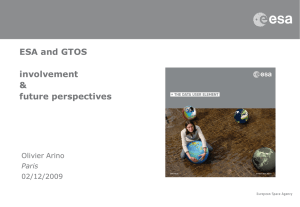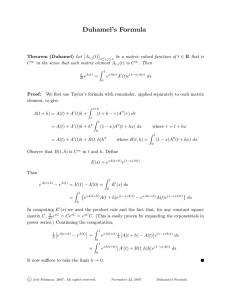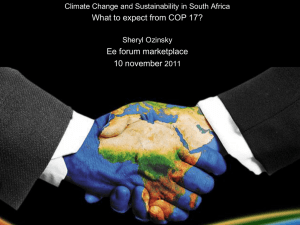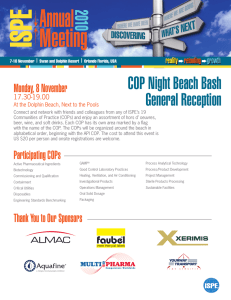ESA and Climate Change
advertisement
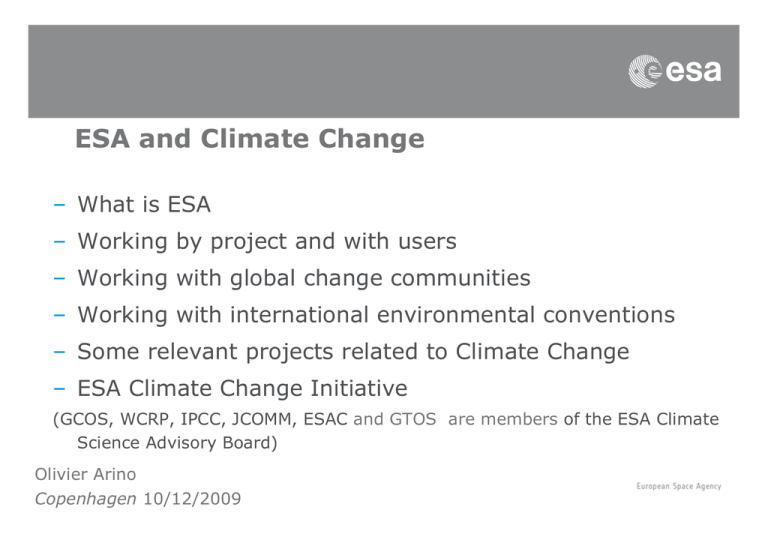
ESA and Climate Change – What is ESA – Working by project and with users – Working with global change communities – Working with international environmental conventions – Some relevant projects related to Climate Change – ESA Climate Change Initiative (GCOS, WCRP, IPCC, JCOMM, ESAC and GTOS are members of the ESA Climate Science Advisory Board) Olivier Arino Copenhagen 10/12/2009 What is ESA? The European Space Agency ESA has 17 Member States : Austria, Belgium, Denmark, Finland, France, Germany, Greece, Ireland, Italy, Luxembourg, Norway, the Netherlands, Portugal, Spain, Sweden, Switzerland and the United Kingdom. Canada takes part in some projects under a cooperation agreement. 08/2005 - 2 The European Space Agency 30 years experience 5 centers 2000 staff members 3 billion Euro per year 60 satellites developed 15 satellites in operation • Human space flight and exploration • Microgravity research • Earth Observation Continuous data acquisition Long term archive Multi-scale capabilities Multi-sensor information Data Exploitation • Telecommunications • Satellite navigation • Launcher development 08/2005 - 4 Objectives: - to provide global maps of soil moisture and ocean salinity - to advance our understanding of the freshwater cycle - to improve climate, weather and extreme-event forecasting Working by projects With Users User Driven Approach User Groups: National & sub-national public authorities, European institutions, International organizations, NGOs User requirements consolidation Ground truthing In-situ data access Products validation Service assessment Service Development Service Demonstration EO data Products User Commitments To initiate a project, ESA requests to participating user organizations: a Letter of Commitment; a User Requirements Document (URD); Letter of Commitment I will commit X men/month of work to: User Requirement Document The Service required include the provision of the following geo-information products: Coordinate the work of local agencies; • XXX Consolidate the User Requirements; • XXX Provide access to data and information useful for the project; Organize dedicated ground data collection campaigns for the project; Support the validation of the results; Assess the final service from a user The User perspective; The area of interest is the following: …. The timeframe of interest in the following …. The format of the products should be the following: …. The National User Network is made of… The User 400 User Organisations in GSE 300 New User Organisations in DUE DUP / DUE Users NGOs 7% Sub-National Ministries and Agencies 13% Industry 12% International Conventions 3% Scientific Programmes 5% Intergovernmental Organisation 8% Research Bodies 16% National Ministries and Agencies 36% ~150 national ministries and agencies ~100 research institutions ~few private companies and non-governmental organisations ~70 new users brought in 2008 and another 70 in 2009 User Consultations in 2008 and 2009 Map in construction – Urban Heat Island, June 2007, NOA, Athens, 50 participants Climate Change – GlobWave, September 2007 , Ifremer, Brest,, 150 participants – Support to Aviation for Volcanic Ash Avoidance, November 2007, MeteoFrance, Toulouse, 30 participants – GlobSnow, February 2008, University of Bern, 30 participants. – Permafrost, February 2008, Alfred Wegener Institute, Potsdam, 40 participants Climate Change – GlobAlbedo, September 2008, ESRIN, Frascati, 20 participants – PostKyoto, December 2008, Poznan, 10 side events Climate Change Climate Change January 2009, DWD, Offenbach, 20 participants – GlobVapour, – GlobWetland II, March 2009, “La Tour du Valat”, Arles, 50 participants Change – CoastColour, March 2009 National Maritime Center, Cork, Climate 50 participants Climate Change – GlobCloud, March 2009, FUB, Berlin, 80 participants Working with Global Change Communities ESA Projects relevant to climate change GlobSeries branding PERMAFROST Working with International Environmental Conventions ESA participate to UNFCCC, UNCCD, UNCBD and Ramsar COPs Map in construction – World Summit, Johannesburg, 2002 – UNFCCC COP 8, New Delhi, 2002 – RAMSAR COP 8, Valencia, 2002 – UNFCCC COP 9, Milan, 2003 – UNCCD COP 6, La Havana, 2003 – UNFCCC COP 10, Buenos Aires, 2004 – UNCCD COP 7, Nairobi, 2005 – RAMSAR COP 9, Kampala, 2005 – UNFCCC COP 11, Montreal, 2005 – UNFCCC COP 12, Nairobi, 2006 – UNCCD COP 8, Madrid, 2007 – UNFCCC, COP 13, Bali, 2007 – RAMSAR COIP 10, Changwon, 2008 – UNCBD COP 9, Bonn, 2008 – UNFCCC COP 14, Poznan, 2008 – UNCCD COP 9, Buenos Aires, 2009 – UNFCCC COP 15, Copenhagen, 2009 booth side events exibition articles TV shots Tracking of Hammerhead sharks (background SST map) ATSR World Fire Atlas ATSR-WFA ALGO1 hot spots 140000 120000 100000 # 80000 60000 40000 20000 0 10 20 09 20 08 20 07 20 06 20 05 20 04 20 03 20 02 20 01 20 00 20 99 19 98 19 97 19 96 19 Time Arino and Casadio, 2009 Papers related to ATSR-WFA 35 30 25 - 20 15 10 5 0 1997 1998 1999 2000 2001 2002 2003 Time 2004 2005 2006 2007 2008 2009 www.esa.int/due/ionia/wfa/ ATSR-WFA: user trends ATSR-WFA Users 95000 100000 90000 NRT 80000 Registered 70000 Web-tool # 60000 1900 x 20 50000 40000 30000 850 x 20 20000 10000 0 2006 2007 2008 2009 2010 New York Time, Liberation, 30 August 2007 Time NRT on-line May 2006 Web-Tool May 2007 Registered before 2006 ~ 70 Fire Greece Web-Tool + GoogleEarth Aug 2007 May 2009 ESA web story Carbon cycle GlobCarbon ‘Champion’ Users Four key research institutes, one GMES project and one key programme involved to specify needs and use products. VITO implemented and operated the processing. GlobCarbon products & Validation Brazil 9000 60000 8000 50000 Hot Spots 6000 40000 5000 30000 4000 3000 20000 2000 10000 1000 0 0 J F M A M J J A S ON D J F M A M J J A S ON D J F M A M J J A SO N D J F M AM J J A SO N D J F M AM J J A SO N D J F M A M J J A S ON D J F M A M J J A S ON D J F M A M J J A SO N D J F M AM J J A SO N D J F M AM J J A SO N D 1998 1999 2000 2001 ATSR WFA 2002 2003 2004 2005 2006 GlobCarbon Burned Area Estimate Jan Feb Mar Apr May Jun Jul Aug Sep Oct Nov Dec 2007 Burned Area Estimates 7000 GlobCover2009 GLOBCOVER 2009 GLOBCOVER 2009 Validation - the challenge ¾ Validate the product using a new EO dataset ¾ Keep the scientific & validation standards high ¾ Find a cost-effective solution ¾ Re-use available resources …using the already-developed infrastructure from GlobCover V2.2 ts oin p 5 42 8 s ert p x e 16 9 A large random sample network has been already developed 9 Use of multiple validation resources as website interface, MERIS FRS data, NDVI dynamics, other high resolution data platforms as Google Earth etc. 9 Use of the previous validation experience and established expert network 9 Cost-effective solution GLOBCOVER 2009 Distribution - News Newsletter No9 (October 2009) celebrating 1 year from GlobCover ’s release. Download hits from new users are continuously increasing on GlobCover Ionia Website 83 0 0 ds loa n dow www.esa.int/due/ionia/globcover News: GlobCover in the Times Concise Atlas of the World Distribution strategy is under investigation. Climate Change Initiative Climate Change Initiative To realize the full potential of the long-term global Earth Observation archives that ESA together with its Member states have established over the last thirty years, as a significant and timely contribution to the ECV databases required by United Nations Framework Convention on Climate Change (UNFCCC). • Implement all steps necessary for the systematic generation and regular updating of the relevant ECVs, • A coherent and continuous suite of actions fully coordinated with ongoing international efforts in the climate change community (eg. WCRP, IGBP) • Ensure full capital is derived from on-going & planned ESA missions for climate purposes, • Focus on 11 ECVs (ESA missions) Climate Change Initiative The International Partners: • UNFCCC which coordinates the interests and decisions of its Parties on Climate Policy, • GCOS which represents the scientific and technical requirements of the Global Climate Observing System on behalf of UNFCCC, • CEOS which serves as a focal point for Earth Observation related activities of Space Agencies • Individual Partner Space Agencies with whom ESA cooperates bilaterally ( e.g. NOAA, NASA, JAXA, CNES, Eumetsat) • International Climate Research Programmes, which represent the collective interests and priorities of the worldwide climate research (e.g WCRP, IGBP) • EC and National Research Programmes which establish research priorities and provide resources for climate research community within Europe (eg EC Framework Programme) Climate Change Initiative The Essential Climate Variables: ECV Ocean Sea Ice Sea Level Sea Surface Temperature Ocean Colour Terrestrial Glaciers and Ice Caps Land Cover Fire Disturbance Atmosphere Cloud properties Ozone Aerosol properties Greenhouse Gases Future Perspectives The next 20 years – GMES Sentinels free and open data policy – Doing science with operational observations – Stimulating exploitation (GMES services) – Consolidating Climate Change Initiative – Consolidate institutional relations with International Environmental Conventions http://www.esa.int olivier.arino@esa.int
